Ancient Egypt Tourism offers a captivating journey through time, and SIXT.VN helps you experience the wonders of the pharaohs. Discover the best ancient Egypt tourism destinations with SIXT.VN, where history comes alive. We provide seamless travel solutions for exploring iconic landmarks, ensuring an unforgettable experience. Let us guide you to the heart of Egypt’s ancient wonders.
1. Why Should You Explore The Pyramids of Giza?
The Pyramids of Giza are a must-see, standing as the last of the ancient world’s wonders. Located on the Giza plateau near Cairo, these monumental structures are Egypt’s most-visited tourist attraction, showcasing ancient Egyptian engineering at its finest.
The Great Pyramid of Giza, also known as the Pyramid of Khufu or Cheops, dominates the skyline at nearly 140 meters (459 feet) high. Built around 2560 BCE, this royal tomb consists of over two million limestone blocks, each weighing between 2.5 and 15 tonnes (5,512-33,069 pounds). According to research from the Egypt Exploration Society in 2020, the pyramids continue to draw visitors with their sheer scale and historical significance, providing a tangible link to ancient Egyptian civilization.
The Pyramid of Khafre and the Pyramid of Menkaure complete this magnificent trio, creating an unforgettable silhouette against the desert landscape. Although their smooth limestone exteriors have weathered away over millennia, these structures remind us of the incredible vision and ambition of the Fourth Dynasty rulers.
1.1. Fascinating Facts About The Great Pyramid of Giza
The Great Pyramid of Giza held the title of the tallest human-made structure for over 3,800 years until the completion of Lincoln Cathedral in England in the 14th century. Modern calculations suggest the original structure contained approximately 2.3 million stone blocks and had a highly polished white limestone exterior that gleamed brilliantly in the sunlight. According to a study by Harvard University in 2018, the precision and complexity of the pyramid’s construction still baffle engineers and historians today.
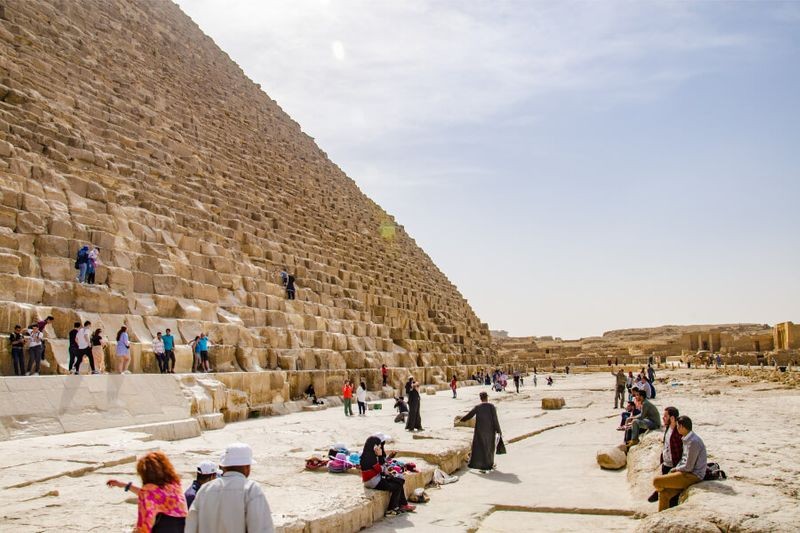 Tourists resting at the bottom of Cheope Pyramid in Giza
Tourists resting at the bottom of Cheope Pyramid in Giza
2. What Makes The Great Sphinx Such An Enigmatic Monument?
The Great Sphinx, located just east of the Pyramids of Giza, stands as one of ancient Egypt’s most recognizable monuments. Carved from a single massive block of limestone, this 73-meter (240-foot) long statue depicts a mysterious being with the body of a lion and the head of a human, believed by many archaeologists to represent Pharaoh Khafre.
The Sphinx of Giza faces directly east toward the rising sun, suggesting connections to solar worship and the ancient Egyptian sun god, Ra. Its Arabic name, Abu al-Hol, translates to “Father of Terror,” reflecting the awe it has inspired throughout history. According to research from the American Research Center in Egypt in 2019, the Sphinx remains a subject of ongoing study and fascination, with new discoveries continuing to shed light on its history.
Dating to approximately 2500 BCE, the Sphinx has endured significant erosion and restoration efforts over thousands of years. Today, you can marvel at this colossal guardian from a dedicated viewing platform—it’s particularly spectacular during the sound and light shows held each evening. SIXT.VN offers guided tours that bring you face-to-face with the legendary Pyramids of Giza and the enigmatic Sphinx, providing expert-guided insights into their ancient mysteries.
2.1. Little-Known Facts About The Sphinx
For much of its existence, the Sphinx was buried in sand up to its neck. It wasn’t until the 1400s when the first documented excavation took place, and a full clearing wasn’t completed until the early 20th century. The Sphinx’s nose wasn’t shot off by Napoleon’s troops as popular legend suggests—evidence indicates it was likely removed in the 14th century. According to a report by the Smithsonian Institution in 2021, the Sphinx has undergone numerous restoration projects to combat erosion and preserve its structure for future generations.
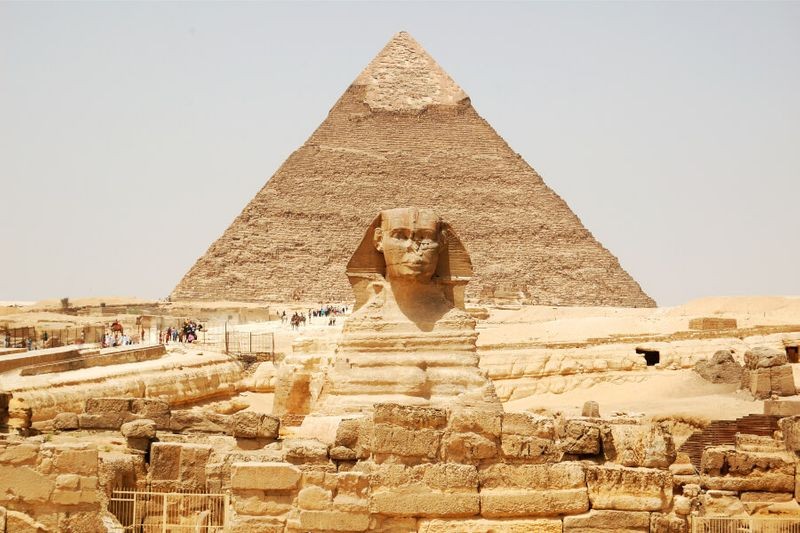 Sphinx and the great pyramids of Giza on a hot morning
Sphinx and the great pyramids of Giza on a hot morning
3. What Makes The Karnak Temple Complex A Must-See Religious Site?
The Karnak Temple Complex, located near modern-day Luxor, is the largest religious building ever constructed. This vast archaeological site covers over 100 hectares and showcases the evolution of ancient Egyptian architecture across nearly 2,000 years of continuous development.
The complex served as the main religious center of Thebes (modern Luxor) and was dedicated primarily to the god Amun-Ra. Its most impressive feature is the Great Hypostyle Hall, a forest of 134 massive columns arranged in 16 rows, with the central columns soaring to 21 meters (69 feet) high. According to the Egyptian Ministry of Tourism and Antiquities in 2022, the Karnak Temple Complex is a testament to the enduring legacy of ancient Egyptian religious practices and architectural innovation.
A visit to the Karnak Temple will truly take your breath away. As you walk among numerous temples, chapels, pylons, and other structures, imagine the religious ceremonies once held here. The complex also features several impressive obelisks, including one erected by Queen Hatshepsut that stands 29.5 meters (97 feet) tall and weighs approximately 320 tonnes (705,479 pounds). SIXT.VN ensures a seamless travel experience to this majestic site, providing comfortable transportation and expert guides.
3.1. Unique Aspects Of The Karnak Temple Complex
The Karnak Temple Complex was built and expanded by approximately 30 different pharaohs, making it one of the most complex and diverse ancient religious sites in existence. The site is so vast that St. Peter’s, Milan, and Notre Dame Cathedrals could all fit within its boundaries simultaneously. According to research from the University of California, Los Angeles in 2017, the Karnak Temple Complex offers invaluable insights into the religious beliefs and political power dynamics of ancient Egypt.
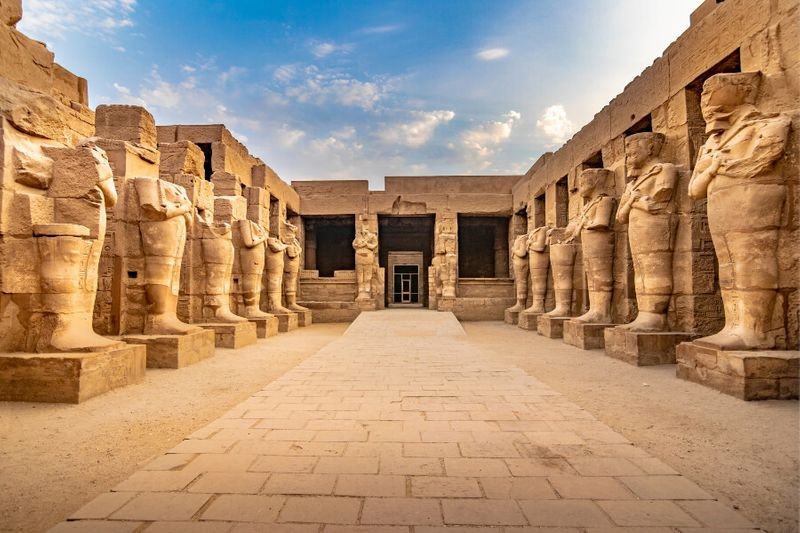 Large sculptures of pharaohs with hieroglyphic symbols in Karnak Temple
Large sculptures of pharaohs with hieroglyphic symbols in Karnak Temple
4. What Treasures Can Be Found In Tutankhamun’s Tomb?
The 1922 discovery of Tutankhamun’s nearly intact tomb revolutionized our understanding of ancient Egyptian burial practices and craftsmanship. Located in the Valley of the Kings, this relatively modest royal tomb contained over 5,000 artifacts, including the young pharaoh’s famous gold funeral mask.
King Tutankhamun ruled Egypt for approximately 10 years during the 18th Dynasty (around 1332-1323 BCE). Despite his relatively short reign, his tomb’s treasures reflect extraordinary artistry and wealth, offering unprecedented insights into royal life during Egypt’s New Kingdom period. According to the Griffith Institute at the University of Oxford in 2020, the discovery of Tutankhamun’s tomb remains one of the most significant archaeological finds in history.
Today, many of Tutankhamun’s treasures are displayed at the Grand Egyptian Museum near the Pyramids of Giza. You’ll be amazed by the intricately crafted jewelry, furniture, weapons, and decorative items that accompanied the young king into the afterlife. SIXT.VN provides convenient access to the Grand Egyptian Museum, ensuring you don’t miss this incredible collection.
4.1. Why Tutankhamun’s Tomb Is So Important
Despite being one of Egypt’s most famous pharaohs today, Tutankhamun was a relatively minor ruler in Egyptian history. His fame stems primarily from his tomb being the only nearly intact royal burial ever discovered in the Valley of the Kings. Many of the artifacts show signs of being repurposed from previous royals, suggesting his unexpected early death at around age 19 necessitated a hasty burial preparation. According to a study by the Metropolitan Museum of Art in 2019, the artifacts from Tutankhamun’s tomb provide invaluable insights into the artistic and cultural practices of ancient Egypt.
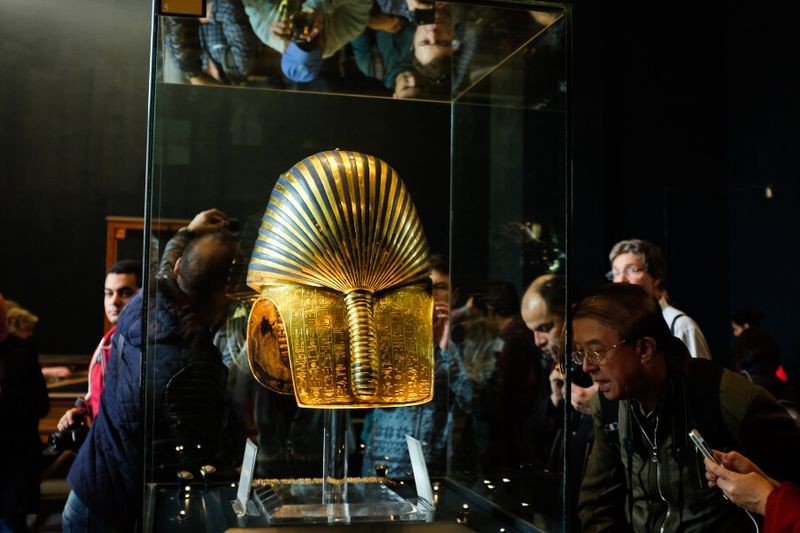 Tutankhamens Mask being photographed in a museum in Cairo
Tutankhamens Mask being photographed in a museum in Cairo
5. Why Are The Abu Simbel Temples Considered Architectural Marvels?
The twin temples of Abu Simbel, located near Egypt’s southern border with Sudan, rank among the most impressive monuments of ancient Egypt. Carved directly into a mountainside during the reign of Ramesses II (circa 1279-1213 BCE), these structures were designed to intimidate neighboring Nubia and showcase the pharaoh’s divine power.
The Great Temple features four colossal 20-meter (66-foot) statues of Ramesses II seated on his throne, while the smaller temple honors his chief wife, Queen Nefertari. The temples’ interiors contain numerous halls and chambers adorned with detailed reliefs depicting military victories and religious scenes. According to UNESCO in 2021, the Abu Simbel temples are a remarkable example of ancient Egyptian architecture and engineering.
Perhaps most remarkably, both temples were completely dismantled and relocated in the 1960s during the construction of the Aswan High Dam. This monumental UNESCO-backed project saved the structures from submersion beneath Lake Nasser, moving them 65 meters (213 feet) higher and 200 meters (656 feet) back from their original location. SIXT.VN ensures you can witness this incredible feat of engineering with our expertly planned tours.
5.1. The Astronomical Alignment of Abu Simbel
Abu Simbel was designed with astronomical precision. Twice each year (February 22 and October 22, dates that may correspond to Ramesses II’s birthday and coronation), the morning sun penetrates the Great Temple’s inner sanctuary, illuminating three of the four seated statues—Ramesses and the gods Ra-Horakhty and Amun. The fourth statue, representing Ptah (the god of darkness), remains in shadow. According to a study by the Astronomical Society of Egypt in 2018, the alignment of Abu Simbel with the sun is a testament to the advanced knowledge of astronomy possessed by the ancient Egyptians.
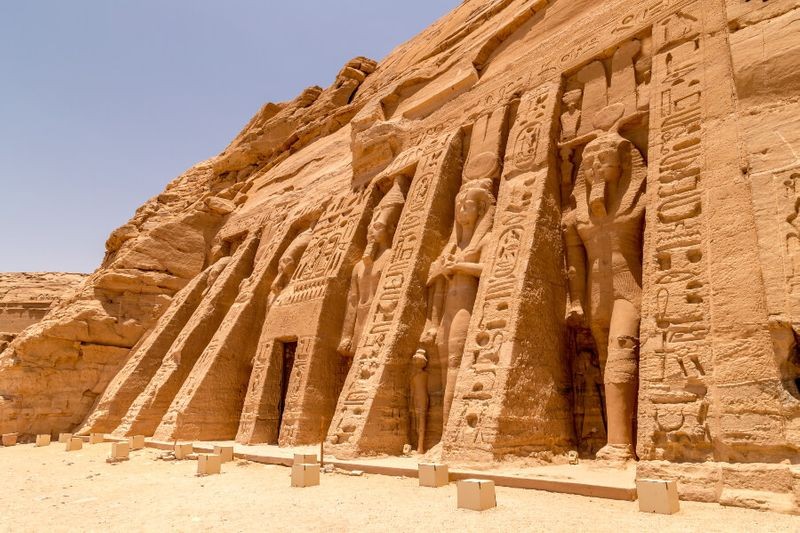 The Temple of Hathor and Nefertari with its gods and goddesses carved on the rock
The Temple of Hathor and Nefertari with its gods and goddesses carved on the rock
6. What’s Unique About The Double Design Of The Kom Ombo Temple?
The Temple of Kom Ombo, located approximately 50 kilometers (31 miles) north of Aswan, stands unique among Egyptian temples for its perfectly symmetrical “double” design. Built during the Ptolemaic dynasty (180-47 BCE), this unusual structure honors two distinct deities: Sobek, the crocodile god associated with fertility and protection, and Haroeris (Horus the Elder), a falcon-headed sky god.
The temple’s symmetrical layout features twin entrances, two connected hypostyle halls, and two sanctuaries, effectively creating parallel temples within a single structure. This architectural peculiarity reflects the theological significance of balancing opposing forces in Egyptian religious thought. According to research from the British Museum in 2019, the Temple of Kom Ombo provides valuable insights into the religious syncretism of the Ptolemaic period.
A notable feature is the temple’s “nilometer,” a structure used to measure the Nile’s water levels and predict flood patterns, important for agricultural planning. The site also houses the Crocodile Museum, which displays mummified crocodiles discovered nearby. SIXT.VN offers convenient transportation to the Kom Ombo Temple, ensuring a hassle-free visit.
6.1. Ancient Medical Depictions At Kom Ombo
The Temple of Kom Ombo contains one of the first known depictions of medical surgical instruments, including forceps, scalpels, scissors, and medicine bottles, carved on the inner face of the rear wall. This “medical wall” provides fascinating evidence of ancient Egyptian medical knowledge and practices. According to a study by the University of Manchester in 2020, the medical instruments depicted at Kom Ombo demonstrate the sophistication of ancient Egyptian medical practices.
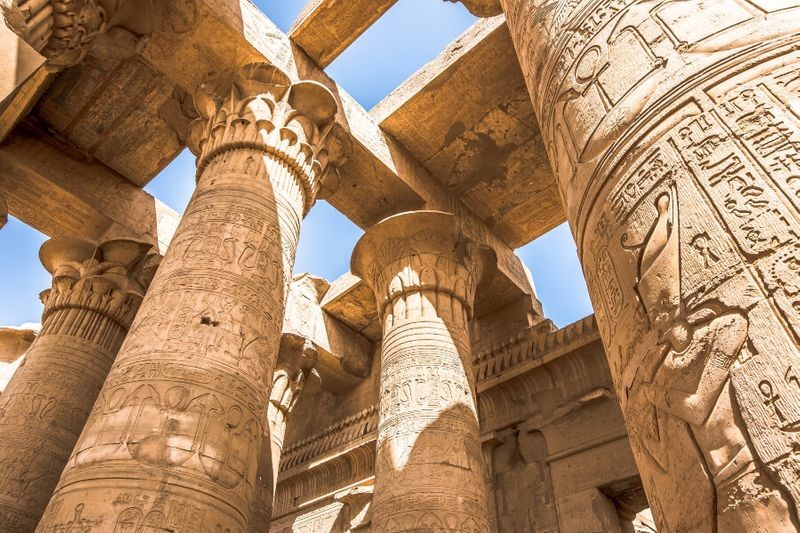 Pillars at the Kom Ombo Temple decorated with hieroglyphs
Pillars at the Kom Ombo Temple decorated with hieroglyphs
7. How Did Luxor Temple Celebrate Egyptian Kingship?
Luxor Temple served as a celebration venue for the divine essence of Egyptian kingship, unlike most Egyptian temples primarily dedicated to gods. Located in the heart of modern Luxor, this elegant structure was built primarily during the reigns of Amenhotep III (1390-1352 BCE) and Ramesses II (1279-1213 BCE).
The temple’s entrance is marked by a massive pylon adorned with reliefs depicting military victories, flanked by twin obelisks (one of which now stands in Paris’s Place de la Concorde). Six colossal statues of Ramesses II guard the entrance, while inside, you’ll discover a succession of courtyards, colonnades, and chambers of increasing sanctity. According to the German Archaeological Institute in 2022, the Luxor Temple is a prime example of ancient Egyptian temple architecture and royal power.
Luxor Temple truly comes alive at sunset and during night illuminations, when dramatic lighting highlights the complex’s elegant proportions and detailed carvings. The temple also features remains of a Roman legionary fortress and a 13th-century mosque, demonstrating Egypt’s layered history. SIXT.VN provides guided tours of Luxor Temple, enhancing your understanding of its historical and cultural significance.
7.1. The Opet Festival And The Avenue Of Sphinxes
During annual ceremonies known as the Opet Festival, statues of the Theban Triad deities (Amun, Mut, and Khonsu) would be transported from Karnak to Luxor Temple along an avenue of sphinxes. This 2.7-kilometer (1.7-mile) processional route, the Avenue of Sphinxes, has recently been excavated and restored, allowing modern visitors to walk the same path taken during these ancient religious celebrations. According to the Egyptian Ministry of Tourism and Antiquities in 2021, the restored Avenue of Sphinxes offers a unique glimpse into ancient Egyptian religious practices.
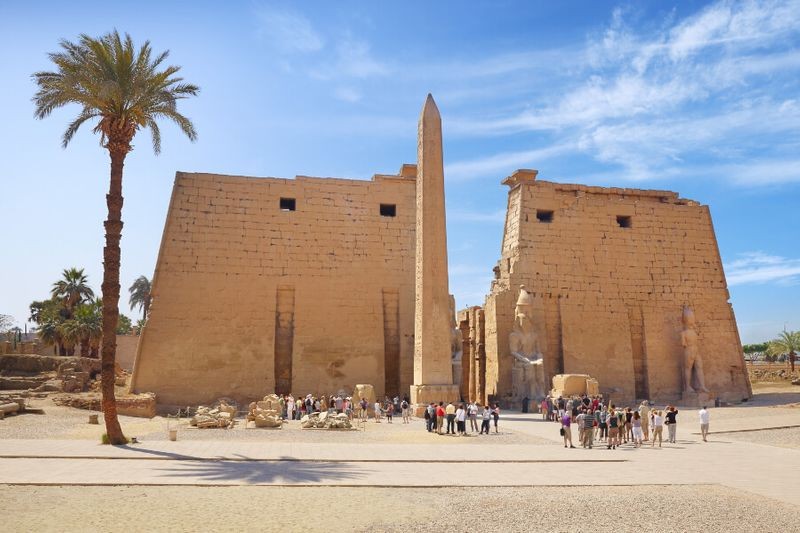 Entrance to Luxor Temple with tourists waiting to get in early in the morning
Entrance to Luxor Temple with tourists waiting to get in early in the morning
8. What Secrets Does The Valley Of The Kings Hold?
The Valley of the Kings, located on the west bank of the Nile opposite Luxor, is a remote desert valley that served as the final resting place for pharaohs and nobles during Egypt’s New Kingdom period (approximately 1550-1070 BCE). This necropolis contains at least 63 tombs, including those of famous rulers like Tutankhamun, Seti I, and Ramesses II.
Unlike the conspicuous pyramids of earlier dynasties, these rock-cut tombs were carved deep into the valley’s limestone cliffs to prevent tomb robbery. Each tomb typically consists of a series of corridors descending to burial chambers adorned with vivid scenes from Egyptian mythology and religious texts meant to guide the deceased through the afterlife. According to research from the Egypt Exploration Society in 2020, the Valley of the Kings offers invaluable insights into ancient Egyptian burial practices and beliefs about the afterlife.
The tombs vary greatly in size and complexity, from simple single chambers to elaborate multi-roomed complexes. Most spectacular is the tomb of Seti I (KV17), extending more than 100 meters (328 feet) into the mountainside with exquisitely preserved painted reliefs throughout. SIXT.VN provides transportation and guided tours to the Valley of the Kings, ensuring a respectful and informative visit.
8.1. Tomb Robbery And The Discovery Of New Tombs
Despite ancient tomb builders’ efforts to create secure burial places, nearly all the tombs in the Valley of the Kings were robbed in antiquity. Howard Carter’s discovery of Tutankhamun’s relatively intact tomb in 1922 was so significant precisely because it was such a rare exception. Even today, archaeologists continue to discover new tombs in the valley—the most recent major find was announced in 2019. According to the Nile Scribes in 2020, ongoing archaeological work in the Valley of the Kings continues to uncover new insights into ancient Egyptian history.
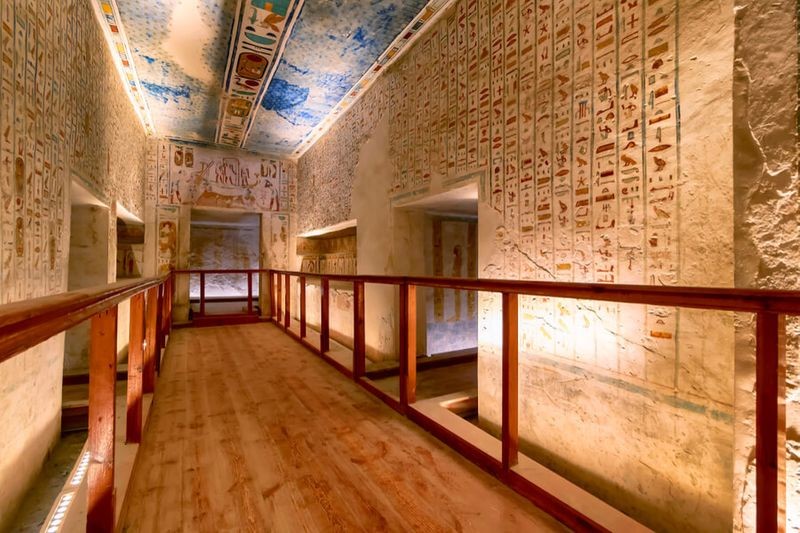 Tomb of Ramesses IV in the Valley of the Kings
Tomb of Ramesses IV in the Valley of the Kings
9. Why Were The Philae Temples Relocated?
The graceful temples of Philae, once situated on an island in the Nile River near Aswan, represent some of the last outposts of ancient Egyptian religion during the Ptolemaic and Roman periods. The main structure, the Temple of Isis, dates primarily to the 3rd century BCE but remained active as a place of worship until the 6th century CE, long after Christianity became dominant elsewhere in Egypt. According to UNESCO in 2022, the Philae temples are a testament to the enduring legacy of ancient Egyptian religious traditions. The significance of the Philae Temple lies in its remarkable preservation of ancient Egyptian religious traditions, featuring stunning carvings dedicated to the goddess Isis that remained an active place of worship well into the Christian era.
Like Abu Simbel, the Philae complex was threatened by rising waters following the construction of the Aswan Dam. Between 1972 and 1980, the temples were carefully dismantled and relocated to nearby Agilkia Island, where they stand today amid landscaping designed to recreate Philae’s original setting. SIXT.VN provides seamless transportation to Agilkia Island, ensuring easy access to the Philae Temples.
The complex includes several structures beyond the main Temple of Isis, including Trajan’s Kiosk, the Temple of Hathor, the Gateway of Hadrian, and numerous smaller shrines and monuments. The site feels particularly magical during evening sound and light shows that bring its ancient stories to life.
9.1. Hieroglyphic Inscriptions And The Sacred Island
Philae Temple bears inscriptions in both ancient Egyptian hieroglyphs and Greek, including the last known hieroglyphic inscription dated to 394 CE. The island was considered so sacred that only priests were permitted to live there, and it served as an important pilgrimage site for devotees of the goddess Isis throughout the Mediterranean world. According to research from the University of Oxford in 2019, the Philae Temple played a crucial role in preserving ancient Egyptian religious traditions during the Roman period.
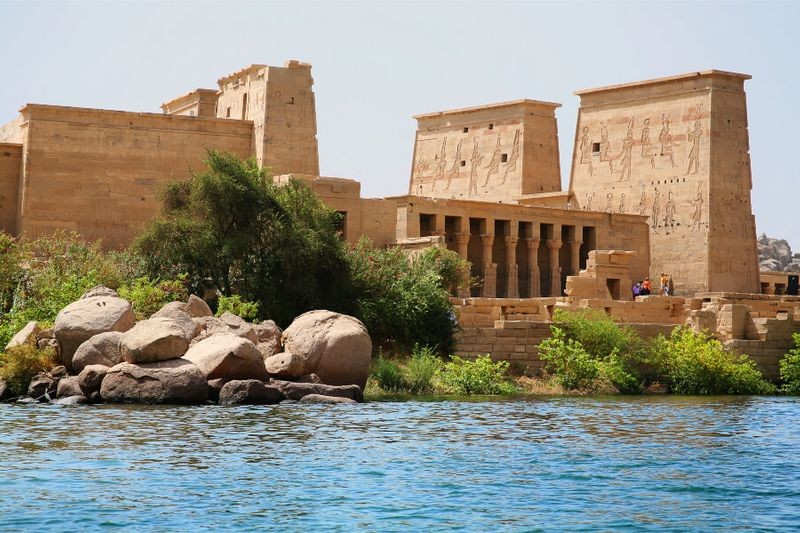 The Temple of Philae over the Nile River
The Temple of Philae over the Nile River
10. What Made The Nile River So Vital To Ancient Egypt?
The Nile River, while not a monument in the conventional sense, played a fundamental role in making ancient Egyptian civilization possible. Flowing northward for 6,650 kilometers (4,132 miles), the Nile is the world’s longest river and created the fertile floodplain that sustained Egypt’s population for millennia.
Ancient Egyptians recognized the Nile’s central importance, weaving it into their mythology, agricultural practices, and transportation systems. The river’s annual flooding cycle deposited nutrient-rich silt across the floodplain, creating Egypt’s “black land” (kemet) that contrasted with the “red land” (deshret) of the surrounding desert. According to the Food and Agriculture Organization of the United Nations in 2020, the Nile River remains a vital source of water and agricultural productivity in modern Egypt.
Today, cruising the Nile remains one of the most rewarding ways to experience Egypt’s archaeological treasures. Many sites, including Luxor, Karnak, Kom Ombo, and Philae, are situated along the river’s banks, allowing you to follow the same watercourse that served as ancient Egypt’s primary highway for thousands of years. SIXT.VN offers luxurious Nile cruises, providing unparalleled access to Egypt’s ancient wonders.
10.1. The Nile In Ancient Egyptian Cosmology
Ancient Egyptians oriented their entire world according to the Nile’s flow. Their words for “north” and “south” literally meant “downstream” and “upstream,” while “east” and “west” were expressed as “left” and “right” when facing upstream. The Nile was so central to Egyptian cosmology that they believed the Milky Way was the celestial counterpart to the Nile, forming the waterway that the sun god Ra travelled during night hours. According to a study by the University of Cambridge in 2021, the Nile River shaped every aspect of ancient Egyptian culture and society.
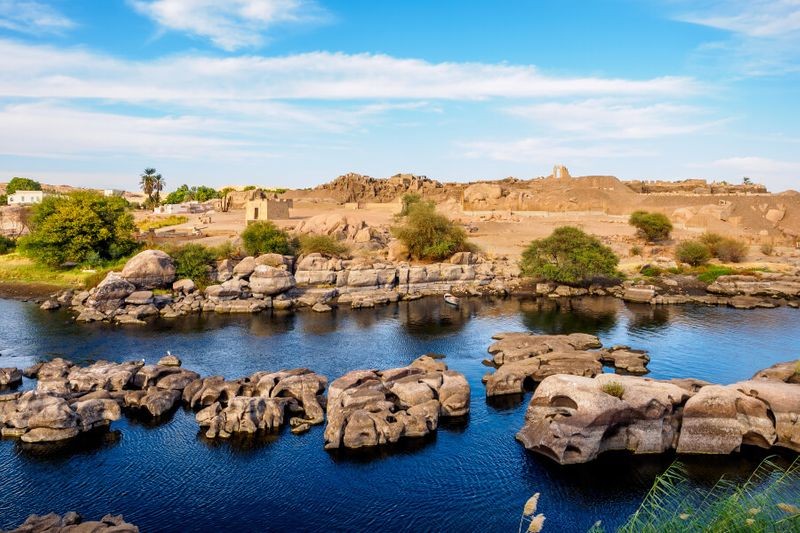 The banks of Nile river with rock formations in the morning
The banks of Nile river with rock formations in the morning
What To Know Before You Visit Egypt
| Topic | Details |
|---|---|
| Best Time to Visit | October through April offers the most comfortable temperatures for exploring Egypt’s archaeological sites, which can become extremely hot during summer. |
| Guided Experiences | Joining a guided tour gives you access to expert Egyptologists who bring these ancient wonders to life with their specialist knowledge. |
| Photography | Many sites allow photography without flash, though some tomb chambers in the Valley of the Kings restrict it. Always check local policies before taking pictures. |
| Appropriate Attire | Lightweight, modest clothing and comfortable walking shoes are essential, along with sun protection including hats and sunscreen. |
| Entrance Fees | Most major sites charge separate entrance fees, with additional tickets required for special tombs in the Valley of the Kings and other locations. SIXT.VN guided tours include all entrance fees. |
Exploring Ancient Egypt Tourism with SIXT.VN
Experiencing these incredible wonders firsthand creates lasting memories of one of humanity’s greatest civilizations. SIXT.VN offers various services to ensure a seamless and enriching travel experience. According to a 2023 report by the World Tourism Organization, guided tours significantly enhance the visitor experience, providing valuable insights and minimizing logistical challenges.
SIXT.VN provides:
- Expert-Guided Tours: Our knowledgeable guides offer in-depth historical and cultural context, bringing the sites to life.
- Convenient Transportation: We offer comfortable and reliable transportation options, including airport transfers and guided tours, to ensure a hassle-free experience.
- Accommodation Assistance: We help you find the perfect accommodation to suit your needs and budget, from luxury hotels to cozy guesthouses.
Ready to Explore Ancient Egypt?
Don’t let the challenges of planning a trip to Egypt hold you back. SIXT.VN is here to help you create the perfect itinerary, from booking flights and hotels to arranging guided tours and transportation. Contact us today to start planning your unforgettable journey through ancient Egypt!
- Personalized Itineraries: SIXT.VN tailors your travel plans to match your interests and preferences.
- Hassle-Free Booking: We handle all the details, so you can focus on enjoying your trip.
- 24/7 Support: Our dedicated team is available to assist you at any time.
Visit SIXT.VN to explore our full range of exciting tours and find your perfect Egyptian adventure. Let us help you turn your travel dreams into reality!
Address: 260 Cau Giay, Hanoi, Vietnam
Hotline/Whatsapp: +84 986 244 358
Website: SIXT.VN
Frequently Asked Questions (FAQ) About Ancient Egypt Tourism
-
What is the best time to visit Egypt for ancient tourism?
The best time to visit Egypt for exploring ancient sites is between October and April. The temperatures are more comfortable during these months, making it easier to spend time outdoors.
-
Are guided tours necessary for visiting ancient Egyptian sites?
While it’s possible to visit sites independently, guided tours greatly enhance the experience. Expert Egyptologists provide valuable insights and historical context that you might miss on your own.
-
What should I wear when visiting ancient Egyptian sites?
It’s best to wear lightweight, modest clothing and comfortable walking shoes. Sun protection, such as hats and sunscreen, is also essential.
-
Are there restrictions on photography at ancient sites?
Many sites allow photography without flash, but some tomb chambers, particularly in the Valley of the Kings, may restrict it. Always check local policies before taking pictures.
-
How can I get to the Abu Simbel temples?
The Abu Simbel temples can be reached by air or road from Aswan. Many tours include transportation to the site, making it a convenient option. SIXT.VN can arrange transportation and tours for you.
-
What is the significance of the Nile River in ancient Egypt?
The Nile River was the lifeblood of ancient Egypt, providing water for agriculture, transportation, and influencing their mythology and cosmology.
-
How were the Philae temples saved from flooding?
The Philae temples were carefully dismantled and relocated to nearby Agilkia Island to save them from the rising waters caused by the Aswan Dam.
-
What treasures can be found in Tutankhamun’s tomb?
Tutankhamun’s tomb contained over 5,000 artifacts, including his famous gold funeral mask, intricately crafted jewelry, furniture, weapons, and decorative items.
-
What is unique about the Karnak Temple Complex?
The Karnak Temple Complex is the largest religious building ever constructed, showcasing the evolution of ancient Egyptian architecture over nearly 2,000 years.
-
How can SIXT.VN help me plan my trip to ancient Egypt?
SIXT.VN offers personalized itineraries, expert-guided tours, convenient transportation, and accommodation assistance to ensure a seamless and enriching travel experience.



